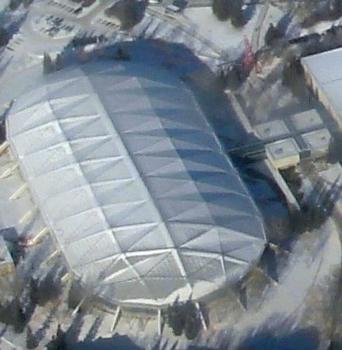General Information
Project Type
| Function / usage: |
Ice rink / ice arena |
|---|
Location
Technical Information
Cost
| cost of construction | Canadian dollar 38 900 000 |
Excerpt from Wikipedia
The Olympic Oval in Calgary, Alberta, Canada, is a covered speed skating oval; it was built for the 1988 Winter Olympics and opened 32 years ago in 1987.
Located on the University of Calgary campus, it is the official designated training center for Speed Skate Canada and the Canadian National Speed Skating team.
In 2012, it commemorated its 25th year of public service with a number of exciting activities and celebrations.
History
The Olympic Oval was designed as the first covered speed skating oval in North America, and was the first at a Winter Olympics. The indoor facility offered the ability to control climate conditions to produce the highest quality ice.
Construction of The Oval began in 1985, nearly four years after Calgary had been designated host of the XV Olympic Winter Games. Like the Olympic Saddledome, most of the Oval's structure was built using precast, prestressed concrete. Twenty eight beams were laid along the outside of the perimeter of the building to support 84 additional beams used to construct a lattice frame for the arched roof. The interior scaffolding used to hoist these 84 beams had to be lowered a centimetre at a time in a predetermined sequence in order to distribute the load of the roof equally to each of the 28 exterior support beams. Construction was completed by the end of the summer of 1987, officially opening in September 1987, five months before the Olympics.
It was during the speed skating events of the Olympic Winter Games in 1988 that The Oval became known as "the fastest ice on Earth," as world records were set in seven events (Men's 500 m, 1500 m, 10,000 m, and Women's 500 m, 1000 m, 3000 m, 5000 m), and Olympic records were set in the other three events (Men's 1500 m, 5000 m, and Women's 1500 m). The combination of the climate-controlled facility and the effects of high altitude have been credited for the fast ice surface.
Throughout the following 14 years the vast majority of speed skating world records were set at The Oval. By 2013, at celebrations for the 25th anniversary of the 1988 Winter Games, the former CEO of the Winter Games said that the Olympic Oval had produced over "150 world record skating times".
Training facility
Along with the 400 m long-track speed skating oval, the Olympic Oval also includes two international-sized ice rinks for short-track speed skating and ice hockey, a 450 m running track surrounding the main oval, and an eight-lane 110 m sprint track for year-round athletics training. By 2013, hundred of Canadian athletes were training in the Oval year round. Saskatoon-native Catriona Le May Doan, who won the gold medal in speedskating at the 1998 Winter Olympics and in the 2002 Winter Olympics began training at the Oval soon after its construction.
The Oval continues to be regarded as a premier speed skating venue, and a preferred training facility for speed skating teams across the globe.
Other activities
When not hosting hockey games and speed skating competitions, The Oval is open to public skating, family day events, and the Calgary Science Fair.
Text imported from Wikipedia article "Olympic Oval" and modified on July 23, 2019 according to the CC-BY-SA 4.0 International license.
Participants
Currently there is no information available about persons or companies having participated in this project.
Relevant Web Sites
Relevant Publications
- (1987): Olympic Oval Roof Structure Design, Production, Erection Highlights. In: PCI Journal, v. 32, n. 6 (November 1987), pp. 50-69.
- (1987): Olympic speedskating oval, Calgary, Canada. Presented at: IABSE Symposium: Concrete Structures for the Future = Structures en béton de l'avenir = Betonbauwerke für die Zukunft, Paris & Versailles, France, 1987.
- About this
data sheet - Structure-ID
20040425 - Published on:
18/11/2008 - Last updated on:
02/09/2024





